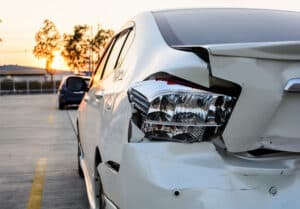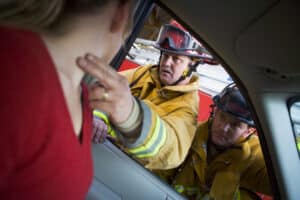Drivers have a legal duty to pay attention to their surroundings, watch their speeds, and remain focused on the road.
When they fail, they may cause a rear-end accident where the front of their vehicle hits the back of another vehicle. These accidents frequently occur at traffic intersections or on busy highways when traffic slows quickly.
If you sustained injuries in a rear-end accident due to another driver's negligence, you should speak with an experienced Phoenix car accident lawyer in your area right away about your potential legal options.
Your lawyer can thoroughly investigate your accident circumstances by obtaining a copy of the police report, retaining an accident reconstructionist, or reviewing photographs and video footage. Your lawyer can then file a claim or lawsuit on your behalf and work to maximize the financial damages you receive for your injuries.
How and Where Do Rear-end Accidents Typically Occur?
Negligence on the road often manifests in a myriad of ways, contributing to the prevalence of rear-end traffic accidents.
One primary cause is distracted driving, a ubiquitous concern in the modern era. When drivers divert their attention to mobile phones, navigation systems, or other distractions, they compromise their ability to react promptly to changes in traffic conditions.
This diversion, coupled with the relentless pace of today's multitasking culture, elevates the risk of rear-end collisions.
Speeding, another significant factor, amplifies the severity of accidents resulting from negligence. Drivers who exceed posted speed limits compromise their ability to brake effectively.

The combination of excessive speed and an inability to decelerate swiftly transforms seemingly minor traffic disruptions into high-impact collisions, often ending in rear-end accidents.
Tailgating, a practice where drivers follow the vehicle in front too closely, is another pervasive form of negligence on the roads. Failing to maintain a safe following distance diminishes the crucial time needed to react to sudden stops or slowdowns.
This reckless behavior significantly heightens the likelihood of rear-end collisions, as the tailgating driver finds themselves with limited options when faced with abrupt changes in traffic flow.
A failure to yield the right-of-way also contributes to the occurrence of rear-end accidents. When drivers neglect to yield in situations such as merging onto highways or making turns, they create situations where the following vehicle has insufficient time to adjust speed.
This lack of coordination and adherence to traffic rules can lead to collisions, with the vehicle in the rear unable to avoid the negligent actions of the lead driver.
Adverse weather conditions further exacerbate the risk of rear-end accidents due to negligence. When drivers fail to adjust their speed and maintain safe distances in inclement weather, the probability of collisions rises significantly.
Reduced visibility, slippery roads, and impaired traction demand heightened attention and caution, which, when neglected, can result in re
How Do You Legally Prove a Rear-end Accident Case?
In seeking legal recourse after a rear-end car crash resulting from negligence, an accident victim must substantiate their case through:
- Establishing the duty of care the rear driver owed. This involves demonstrating that the rear driver had a responsibility to drive safely, maintain a reasonable distance, adhere to traffic laws, and avoid actions that can lead to harm.
- Proving a breach of duty. The victim must present evidence highlighting how the rear driver deviated from the expected standard of care. This can include eyewitness testimonies, surveillance footage, or accident reconstruction analyses. Demonstrating a clear departure from the duty of care strengthens the argument for negligence.
- Causation. The victim must establish a direct link between the rear driver's breach of duty and the resulting injuries or damages. Medical records, expert opinions, and other relevant evidence can help establish a causal connection, emphasizing how the negligence of the rear driver directly led to the harm the victim suffered.
- Documenting the damages incurred. This involves presenting medical records, repair bills, and other evidence detailing the extent of physical injuries, property damage, and financial losses. The more comprehensive the documentation, the stronger the case for recovering damages.
- Eyewitness accounts. Statements from individuals who observed the accident can provide valuable perspectives and corroborate the victim's version of events. These testimonies build a compelling narrative supporting the victim's assertion of negligence.
- Gathering information from the scene of the accident, such as photographs, police reports, and any available surveillance footage. This tangible evidence aids in reconstructing the sequence of events, highlighting the negligence of the rear driver.
- Engaging expert witnesses, such as accident reconstruction specialists or medical professionals, to lend credibility to the victim's case. Their insights and analyses can provide a deeper understanding of the dynamics of the accident, reinforcing the argument for negligence.
A victim seeking legal relief after a rear-end car crash resulting from negligence must establish the duty of care, a breach of that duty, causation, and damages. They often rely on eyewitness accounts, gather scene evidence, and, when necessary, enlist expert witnesses.
By navigating these elements effectively through their car accident lawyer, the victim can build a compelling case to seek rightful compensation for the harm they have endured.
Common Injuries in Rear-end Accidents
Victims of rear-end car accidents often endure a spectrum of injuries, with the nature and severity varying based on factors such as the speed of impact, the use of safety features, and the overall health of the individuals involved.
One prevalent injury is whiplash, a result of the rapid back-and-forth motion of the neck during the collision. Whiplash can lead to neck pain, stiffness, headaches, and, in some cases, long-term discomfort.

Back injuries are another frequent consequence, particularly affecting the spine. The abrupt jolt of a rear-end collision can cause herniated discs, fractures, or other spinal injuries. These conditions may result in persistent pain, limited mobility, and, in severe cases, long-term disability.
Head injuries are a critical concern in rear-end accidents, often stemming from the impact of the collision or from striking objects within the vehicle. Traumatic brain injuries (TBIs) can be life-altering conditions. Victims may experience headaches, dizziness, cognitive impairment, and, in extreme cases, long-term neurological complications.
Facial injuries are not uncommon, especially when airbags deploy. While airbags aim to mitigate harm, they can cause facial lacerations, contusions, or fractures upon deployment. Additionally, dental injuries may occur due to the forceful impact, leading to chipped teeth or more extensive damage.
Chest injuries are a concern, particularly if the victim's body forcefully strikes the steering wheel or dashboard. Contusions, fractures, or internal injuries to organs like the heart or lungs may result. Such injuries can have immediate consequences and may require extensive medical intervention.
Psychological trauma is another significant aftermath of rear-end accidents. Victims may develop post-traumatic stress disorder (PTSD), anxiety, or depression due to the emotional toll of the crash. These mental health effects can impede daily functioning and require specialized attention for recovery.
The most common injuries victims of rear-end car accidents sustain include whiplash, back injuries affecting the spine, head injuries ranging from concussions to traumatic brain injuries, facial injuries including lacerations and dental damage, chest injuries with potential internal organ involvement, and psychological trauma.
Negotiating With the Insurance Company After a Rear-end Accident
Engaging an experienced car accident attorney is paramount when negotiating with the insurance company following a rear-end traffic accident that a negligent driver has caused. The attorney employs a strategic and assertive approach to advocate for the victim's rights and secure rightful compensation.
First, the attorney meticulously assesses the case, delving into the details of the accident to build a compelling narrative. They gather evidence, such as accident reports, medical records, and eyewitness testimonies, to establish the negligence of the rear driver. This comprehensive understanding of the case forms the foundation for effective negotiation.
When speaking with the insurance company, the attorney presents the evidence, emphasizing the liability of the negligent driver. Persuasive communication is essential, and the attorney clearly articulates the victim's damages. This includes medical expenses, property damage, lost income, and any other relevant economic losses incurred due to the accident.
Understanding insurance policies, the attorney determines coverage limits and exclusions. They strategically leverage this knowledge to maximize the compensation sought on behalf of the victim. This involves skillfully negotiating with the insurance adjusters, compelling them to acknowledge the extent of the victim's losses and the liability of their insured client.
The attorney also plays a crucial role in countering any of the insurance company’s attempts to diminish the victim's claim. They rebut arguments aimed at reducing the settlement amount, which may involve challenging disputed liability or assertions that seek to downplay the severity of injuries.
Furthermore, an experienced attorney understands the importance of timing in negotiations. They work diligently to expedite the process while maintaining a strategic pace. This ensures that the victim receives fair compensation promptly, alleviating financial burdens arising from medical bills, vehicle repairs, and other immediate expenses.
Throughout the negotiation process, the attorney remains vigilant in protecting the victim's best interests. They know how to counter tactics that insurance companies employ to minimize payouts. This includes addressing lowball settlement offers, challenging denied claims, and, when necessary, pursuing legal action to secure just compensation for the victim.
An experienced car accident attorney serves as a steadfast advocate when negotiating with the insurance company following a rear-end traffic accident that a negligent driver caused. Their comprehensive understanding of the legal landscape, adept communication skills, and strategic approach vigorously defend the victim's rights so that they receive the compensation they rightfully deserve.
Recovering the Settlement or Litigation Compensation You Need
In the aftermath of a rear-end car accident resulting from negligence, accident victims may be eligible for various forms of monetary compensation through settlements or litigation.
One primary area of compensation pertains to medical expenses they incur due to injuries sustained in the accident. This includes costs associated with hospitalization, surgeries, medications, rehabilitation, and ongoing medical treatments.
The victim may recover these expenses to alleviate the financial burden resulting from the necessary healthcare interventions.

Lost income represents another crucial aspect of compensation. When injuries lead to missed workdays or a diminished capacity to perform job responsibilities, victims can seek reimbursement for the income they would have earned.
This compensation extends beyond the immediate aftermath of the accident, considering potential long-term repercussions on the victim's earning capacity.
Property damage reimbursement is an essential component of compensation, covering the costs of repairing or replacing the damaged vehicle. This ensures that the victim does not face the financial strain of restoring their mode of transportation to its pre-accident condition.
Pain and suffering, both physical and emotional, constitute a significant category of compensation. Beyond tangible economic losses, victims may experience considerable pain, distress, anxiety, and a diminished quality of life.
Compensation for pain and suffering aims to address these intangible harms, acknowledging the profound effects of the accident on the victim's overall well-being.
In cases of severe negligence leading to long-term disability or impairment, victims may recover compensation for future medical expenses and loss of earning capacity. This forward-looking aspect of compensation anticipates ongoing medical needs and the potential limitations on the victim's ability to generate income in the future.
In cases where the negligent behavior is particularly egregious, the accident victim may pursue punitive damages. Unlike compensatory damages that aim to restore the victim to their pre-accident state, punitive damages punish the at-fault party for their intentional or reckless conduct. This serves as a deterrent, discouraging similar behavior.
The favorable monetary compensation available to an accident victim in a rear-end car accident case resulting from negligence encompasses medical expenses, lost income, property damage reimbursement, compensation for pain and suffering, future medical expenses, loss of earning capacity, and, in certain cases, punitive damages.
This comprehensive range of compensation aims to address the diverse consequences of the accident on the victim's physical, emotional, and financial well-being.
Call an Experienced Car Accident Lawyer Near You Today

If you suffered injuries in a rear-end car accident that resulted from another driver's negligence, a car accident attorney in your area can help. Your lawyer can promptly take the necessary legal steps, including filing a personal injury claim or lawsuit on your behalf, to secure the financial recovery you deserve.
If your case requires litigation, your lawyer can properly file a lawsuit and, if necessary, resolve your case at a trial or alternative dispute resolution (ADR) proceeding.